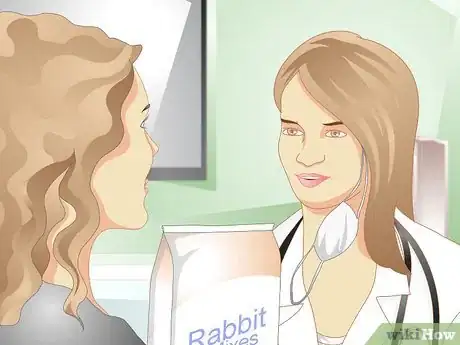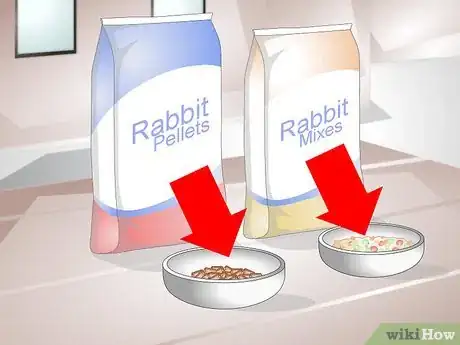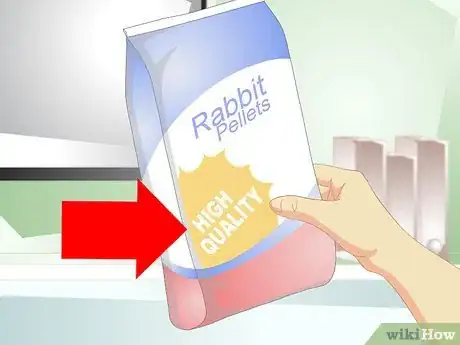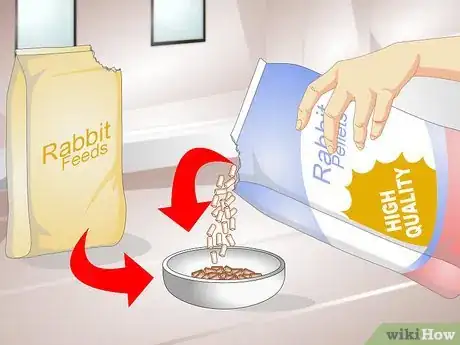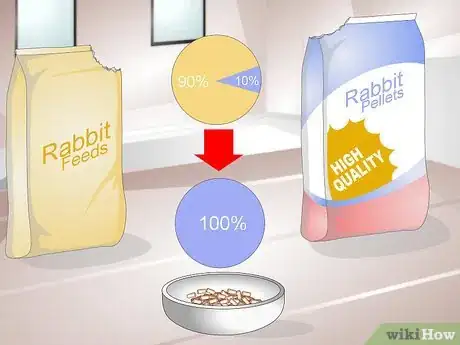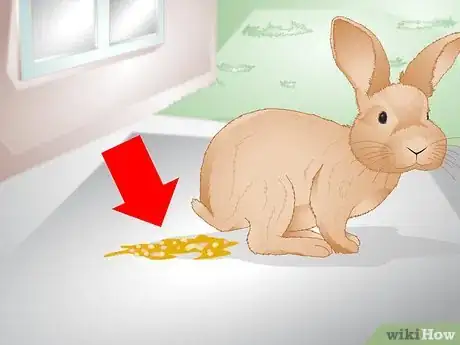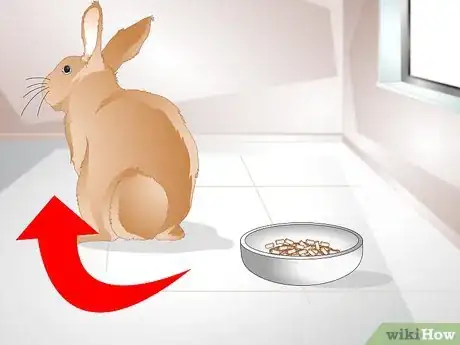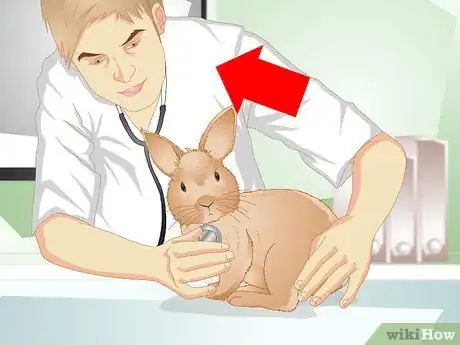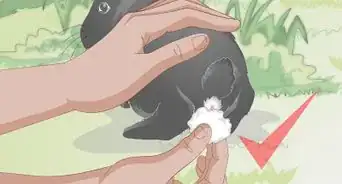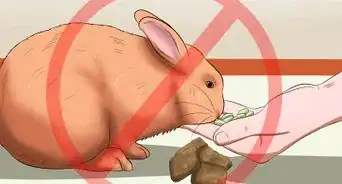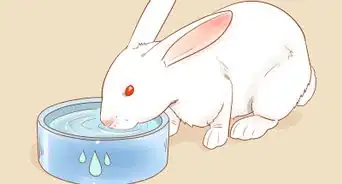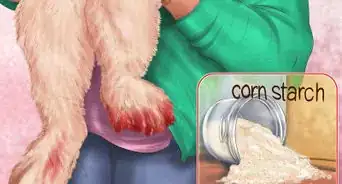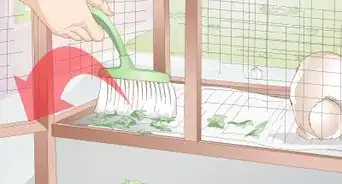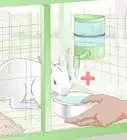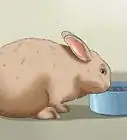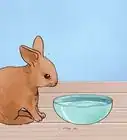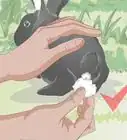This article was co-authored by Pippa Elliott, MRCVS. Dr. Elliott, BVMS, MRCVS is a veterinarian with over 30 years of experience in veterinary surgery and companion animal practice. She graduated from the University of Glasgow in 1987 with a degree in veterinary medicine and surgery. She has worked at the same animal clinic in her hometown for over 20 years.
This article has been viewed 24,800 times.
Has the time come to switch your rabbit’s food brand? Maybe your rabbit’s current food brand isn’t meeting his nutritional needs, or is making him sick. Whatever the reason, you will need to switch food brands carefully so as not to upset your rabbit’s sensitive digestive system. When done correctly, transitioning your rabbit to a new food brand should occur without much incident and improve your rabbit’s overall health.
Steps
Switching Your Rabbit’s Food Brand
-
1Talk with your veterinarian. If you are thinking about switching your rabbit's food brand, or if you have specific concerns about your rabbit's current food, talk with your veterinarian first. He or she can provide you with helpful recommendations on which food brands would provide your rabbit with the best nutrition.[1]
- Bring in the bags of food, or just the food bag labels, to have the discussion with your veterinarian. This will give him or her a better idea of the food's nutritional value.
- Your veterinarian can also examine your rabbit to determine if he has specific health needs that would be best addressed with a different food.
-
2Decide between a pellet and a mix. Commercial dry rabbit food comes in two types: pellets and mixes. Although both types contain similar ingredients, the consistency is different. Mixes have the ingredients separated out (e.g., cereal, flakes of peas), and pellets have all ingredients combined into each pellet.[2]
- Although mixes are more colorful and look more interesting, rabbits often pick out their favorite ingredients and leave the rest. This selective eating can lead to nutritional deficiencies.[3]
- Pellets don’t look very interesting, but will probably give your rabbit more nutrition than a mix. Rabbits are more concerned with the flavor of the food, rather than how it looks.[4]
- Just like switching food brands, switching your rabbit from a mix to a pellet (or vice versa) will need to be a gradual transition. It would be best to switch from a mix to a pellet, since pellets are more nutritionally complete.
Advertisement -
3Select a complete, high-quality commercial rabbit food. When you visit your local pet store, you will probably see a wide array of commercial rabbit foods from which to choose. It might feel overwhelming to decide which one to purchase. Knowing what to look for on the ingredient label will help you make your selection more easily.
- A ‘complete’ food is one that would meet all of your rabbit’s nutritional needs (e.g., protein, vitamins, minerals, fat). Some foods may be labeled as ‘complimentary,’ which means they are not nutritionally complete.[5]
- High-quality foods contain the recommended amount of several key nutrients. For example, look for foods that contain at least 18% fiber (for better digestibility) and 12 to 16% protein (12 to 14% for adult rabbits, and 16% for young rabbits).
- High-quality foods will also be low in fat (about 2 to 5%).[6]
- Grass-based foods tend to be more nutritional balanced than wheat-based foods. Look for a high-quality food that has grass (e.g., timothy, ‘forage’) listed above cereals (e.g., wheats, corn) on the ingredient label.[7]
- Do not be swayed by food brands that have words such as ‘premium,’ ‘gourmet,’ or ‘contains all natural ingredients’ on the bag.[8] These words are more for marketing. Focus on the ingredient label.
-
4Mix the new food in with the old food. Not only is your rabbit’s digestive system sensitive to change, but your rabbit himself may be sensitive to change, too. Rabbits are very routine-oriented, and changes to the routine can cause a rabbit to feel stressed and anxious—more so if they are especially nervous and sensitive. Mix the new food in the old food over about 7 to 14 days to help your rabbit adjust to the new food.[9]
- If you have already discarded the old food, feed the new food in small quantities (less than his usual daily intake). Make sure he has plenty of hay to ensure he is still getting enough nutrients.[10]
- Feed the new food/old mixture as you would normally feed your rabbit—once in in the morning and once in the evening. Divide the total of amount of food in half.
-
5Increase the percentage of new food to old food slowly. The slower the transition, the better. Begin with 10% new food and 90% old food. Each day for 7 to 14 days, increase the percentage of new food until your rabbit is eating 100% new food.[11]
- How much you increase the percentage each day is up to you. Just make sure the increase is gradual.
- As you increase the percentage of new food, make sure not to change the total amount of dry food your rabbit is eating. Feed the same amount of food you normally would.
Monitoring Your Rabbit During the Switch
-
1Look at your rabbit’s feces. Since your rabbit’s digestive system is so sensitive, a rapid switch to a new food brand could cause your rabbit’s feces to become soft or runny. If you notice a change in his feces, scale back on how quickly you are increasing the percentage of new food.[12]
- You may need to go back to a lower percentage of new food, wait until his feces become normal again, then slowly increase the percentage again.
-
2Observe your rabbit’s eating behavior. Do not be surprised if your rabbit does not eat the new food right away. He may like his old food just fine and not be too keen on eating something new. If you notice him eating only the old food, keep the same percentage of new food to old food until he starts eating the new food.
- You may have to keep the same percentage of new food to old food for a few days before he starts eating the new food.
- Your rabbit may be so resistant to the new food that he will urinate on it! If he does this, throw out the food, clean his bowl, and give him the same percentage of new food to old food.
- You will need to have patience and persistence as your rabbit adjusts to the new food brand.
-
3Monitor your rabbit’s overall behavior. Change is stressful for rabbits. Your rabbit may show different signs of stress about eating the new food, including growling or squeaking, lying his ears back tightly against his head, and tensing his body with his tail up.
- Lessening his stress may be as simple as slowing down the rate of switching to the new food brand.
- If your rabbit still seems stressed, you may need to talk to your veterinarian about how to relieve the stress.
-
4Take your rabbit to your veterinarian. If your rabbit is not responding well to the switch in food brands, despite your best efforts to make a smooth transition, take him to your veterinarian for further examination. Your veterinarian could recommend another food brand that would work better for your rabbit.[13]
- If your rabbit's digestive is particularly sensitive to food changes, your veterinarian may also need to prescribe medicines to correct the soft and runny feces.
Expert Q&A
-
QuestionCan you change a rabbit's food?
 Pippa Elliott, MRCVSDr. Elliott, BVMS, MRCVS is a veterinarian with over 30 years of experience in veterinary surgery and companion animal practice. She graduated from the University of Glasgow in 1987 with a degree in veterinary medicine and surgery. She has worked at the same animal clinic in her hometown for over 20 years.
Pippa Elliott, MRCVSDr. Elliott, BVMS, MRCVS is a veterinarian with over 30 years of experience in veterinary surgery and companion animal practice. She graduated from the University of Glasgow in 1987 with a degree in veterinary medicine and surgery. She has worked at the same animal clinic in her hometown for over 20 years.
Veterinarian Yes, rabbits can be changed onto a different diet, but always do this slowly. Never attempt a change by starving the rabbit, as this can result in gut stasis, which is a life-threatening condition.
Yes, rabbits can be changed onto a different diet, but always do this slowly. Never attempt a change by starving the rabbit, as this can result in gut stasis, which is a life-threatening condition. -
QuestionWhat is the best rabbit food?
 Pippa Elliott, MRCVSDr. Elliott, BVMS, MRCVS is a veterinarian with over 30 years of experience in veterinary surgery and companion animal practice. She graduated from the University of Glasgow in 1987 with a degree in veterinary medicine and surgery. She has worked at the same animal clinic in her hometown for over 20 years.
Pippa Elliott, MRCVSDr. Elliott, BVMS, MRCVS is a veterinarian with over 30 years of experience in veterinary surgery and companion animal practice. She graduated from the University of Glasgow in 1987 with a degree in veterinary medicine and surgery. She has worked at the same animal clinic in her hometown for over 20 years.
Veterinarian The ideal and best food for rabbits is fresh, green hay. Pellets should only be offered in small quantities as a supplement to hay and fresh food. When choosing pellets, look for an extruded food, rather than the muesli-type diets.
The ideal and best food for rabbits is fresh, green hay. Pellets should only be offered in small quantities as a supplement to hay and fresh food. When choosing pellets, look for an extruded food, rather than the muesli-type diets. -
QuestionWhat should you feed rabbits?
 Pippa Elliott, MRCVSDr. Elliott, BVMS, MRCVS is a veterinarian with over 30 years of experience in veterinary surgery and companion animal practice. She graduated from the University of Glasgow in 1987 with a degree in veterinary medicine and surgery. She has worked at the same animal clinic in her hometown for over 20 years.
Pippa Elliott, MRCVSDr. Elliott, BVMS, MRCVS is a veterinarian with over 30 years of experience in veterinary surgery and companion animal practice. She graduated from the University of Glasgow in 1987 with a degree in veterinary medicine and surgery. She has worked at the same animal clinic in her hometown for over 20 years.
Veterinarian Wild rabbits eat fresh grass, shoots, and herbage, and a pet rabbit's diet does well to reflect this. In the absence of growing grass, offer good quality green hay. Supplement this with fresh vegetables, fruit, and a small amount of extruded rabbit pellets.
Wild rabbits eat fresh grass, shoots, and herbage, and a pet rabbit's diet does well to reflect this. In the absence of growing grass, offer good quality green hay. Supplement this with fresh vegetables, fruit, and a small amount of extruded rabbit pellets.
Warnings
- Rapid food changes can cause digestive upset in rabbits, such as soft or runny feces.[16]⧼thumbs_response⧽
- Feeding your rabbit unlimited quantities of pellets can lead to obesity and chronic runny feces.[17] Feed your rabbit the pellets only twice a day in the amount recommended for his weight.⧼thumbs_response⧽
References
- ↑ http://www.rabbitrehome.org.uk/care/rabbitfood.asp
- ↑ http://www.rabbitrehome.org.uk/care/rabbitfood.asp
- ↑ http://www.therabbithouse.com/diet/rabbit-food.asp
- ↑ http://www.rabbitrehome.org.uk/care/rabbitfood.asp
- ↑ http://www.rabbitrehome.org.uk/care/rabbitfood.asp
- ↑ http://www.rabbitrehome.org.uk/care/rabbitfood.asp
- ↑ http://www.rabbitrehome.org.uk/care/rabbitfood.asp
- ↑ http://www.therabbithouse.com/diet/rabbit-food.asp
- ↑ http://www.therabbithouse.com/diet/rabbit-food.asp
- ↑ http://www.therabbithouse.com/diet/rabbit-food.asp
- ↑ http://www.therabbithouse.com/diet/rabbit-food.asp
- ↑ http://www.therabbithouse.com/diet/rabbit-food.asp
- ↑ http://www.rabbitrehome.org.uk/care/rabbitfood.asp
- ↑ http://www.therabbithouse.com/diet/rabbit-food.asp
- ↑ http://www.rabbitrehome.org.uk/care/rabbitfood.asp
- ↑ http://www.therabbithouse.com/diet/rabbit-food.asp
- ↑ http://www.sandiegorabbits.org/diet/rabbit-nutrition-veterinarian-article
